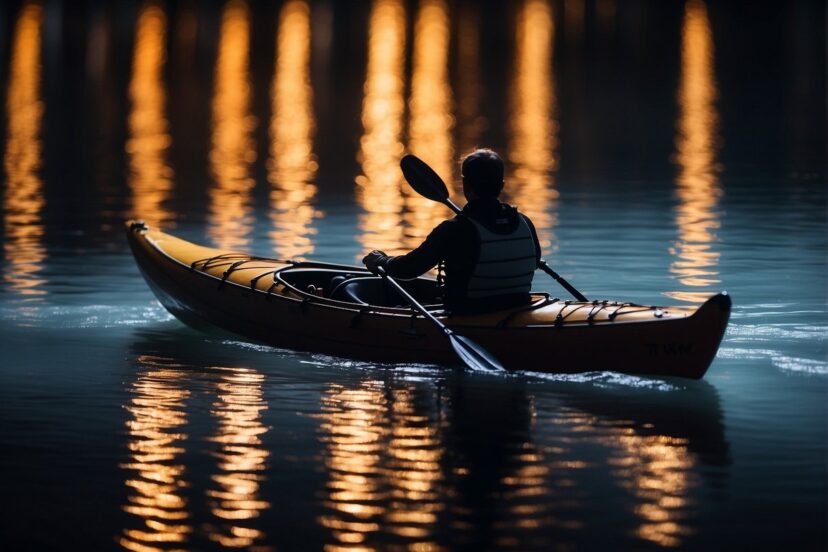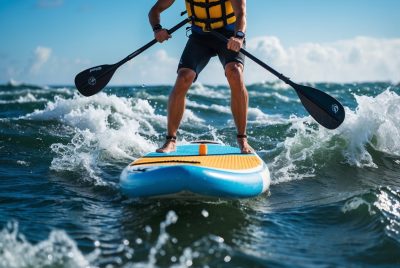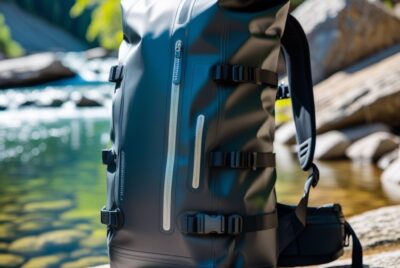Kayak with Lights: Enhancing Your Paddling Experience After Dark
*We may earn a commission for purchases made using our links. Please see our disclosure to learn more.
Kayak with Lights: Enhancing Your Paddling Experience After Dark
Kayaking during the day is an experience that resonates with the serenity and the rhythmic sound of water against the paddle. But kayaking at night introduces a whole new dimension to the adventure. The tranquility of the water in the darkness requires additional measures for safety and visibility, making kayak lights a crucial component of nocturnal paddling. Proper lighting ensures not only my ability to see but also to be seen by others, which is essential in avoiding potential hazards and adhering to maritime regulations.

I consider various options when outfitting my kayak for a night-time trip. There are budget-friendly choices like the Paddlers Supply Company LED Kayak Deck Light that uses a suction cup base for easy installation, as well as more permanent solutions like the YakAttack VISICarbon Pro 360, which serves a dual purpose as both a light and a high-visibility flag. Whether it’s a waterproof headlamp for personal visibility or an LED spotlight for signaling, the right lighting can make all the difference.
Durability and ease of mounting are also critical features I look out for. Some lights come equipped with a tension cable system to ensure a secure fit, while others, like the Railblaza Visibility Kit, offer extended battery life and adjustable heights to suit different kayak models. As these lights play a pivotal role in safety, choosing a reliable light that suits my specific needs is a decision I make with careful consideration.
Understanding Kayak Lights

Kayak lights serve a critical role in ensuring the safety and visibility of kayakers during low-light conditions. They are a vital navigation aid for both signaling to other vessels and illuminating the path ahead. Let’s explore the specifics of their purpose, types, and the legal regulations that apply to them.
Purpose and Importance of a Kayak with Lights
Kayak lights are primarily designed to keep me visible during nighttime or when visibility is compromised, such as in fog or heavy rain. The importance of kayak lights cannot be overstated—they are a crucial safety feature that helps avoid collisions and assists in rescues if necessary. The presence of adequate lighting helps in my navigation and also ensures that other waterway users can see my kayak from a reasonable distance, thereby reducing the risk of accidents.
- Visibility Enhancement: Key for navigation and safety during poor visibility conditions.
- Collision Prevention: Alerts other vessels of my presence to avoid potential accidents.
Types of Kayak Lights
There are several types of kayak lights that I can consider based on the kind of kayaking activity I engage in:
- LED Deck Lights: Provide illumination on the deck of my kayak, aiding in internal visibility and visibility on the water.
- Navigation Lights: Include a combination of green (starboard), red (port), and white (stern) lights that inform other boaters of my direction and position.
- 360-Degree White Lights: Intended for use in all directions, offering visibility from any angle to other water users.
- Underwater Lights: Mounted beneath the kayak; these assist in visibility underwater and can be useful for activities like night fishing.
Choosing the best options depends on my activity, the time of day, and the environmental conditions I’ll be encountering.
Kayak Light Regulations and Legal Requirements
The U.S. Coast Guard has established regulations regarding the use of kayak lights to ensure safety on the waters. As a kayaker, it is my legal obligation to comply with these regulations:
- U.S. Coast Guard Regulations: All kayaks must have at least one bright light, such as a flashlight or 360-degree white light, to be used in time to avoid collisions.
- Legal Requirement: When operating my kayak from sunset to sunrise or in conditions of reduced visibility, proper lighting is not just important for safety, but it’s legally required.
Here is a breakdown of the basic U.S. Coast Guard requirements for kayak lighting:
| Light Type | Visibility Requirement | Usage Scenario |
| 360-degree white light | Visible in all directions | When anchored or in low-visibility conditions |
| Red/green navigation light | Visible from a mile away in designated areas | Required in high-traffic waterways for directional signaling |
| Flashlight | Capable of signaling others in time to prevent a collision | An acceptable minimum for kayaks in non-high-traffic areas |
Adhering to these guidelines not only keeps me within the law but also significantly enhances safety for me and others sharing the waterways.
Selection and Essentials of Kayak Lighting

Selecting the right kayak lights is crucial for safety and compliance with regulations. I’ll guide you through the essentials: choosing durable lights, understanding key features, and navigating mounting options.
Choosing the Right Kayak Lights
When searching for the best kayak lights, focus on LED lights known for their longevity and efficiency. I consider LED units imperative for their bright illumination and low battery consumption. It’s important to choose lights that are explicitly designed for kayak use, as they ensure optimized visibility on the water.
Key Features to Consider
In my experience, the two main features to prioritize are:
- Waterproof Rating: A high IP rating indicates better waterproof capabilities, which is essential for kayak lights. These ratings, like IP67 or IP68, signify that the light can withstand submersion and harsh marine conditions.
- Battery Power: Look for lights that offer extended battery life. The industry standard often includes options that provide up to 100 hours on AAA batteries. Rechargeable batteries are also a viable option for frequent kayakers who seek convenience and sustainability.
Mounting Options for Kayak Lights
The versatility of kayak lights is often dictated by their mounting options. Here are common mounting methods:
- Track Mounts: These are incredibly adaptable and allow for quick adjustments along the kayak’s pre-existing tracks.
- Suction Cup Mounts: Ideal for smooth surfaces, they provide a temporary solution without needing any modification to the kayak.
- Tension Cable Systems: Some lights come with a tension cable mounting system, which offers easy installation and superior durability.
It’s essential to select a mounting system that is sturdy and easy to operate, ensuring the light stays in place even in rough waters.
Installation and Usage of Lights

When I install lights on my kayak, I ensure they serve their purpose for visibility and safety. Here’s how I do it with precision and care.
Step-by-Step Installation Guide
- Selecting the Right Kayak Light: I choose bright, 360-degree visible lights, often LED light strips or portable underwater lights. These ensure other vessels can spot me from any direction.
- Mounting Navigation Lights: I install navigation lights, which are essential for nighttime visibility. These include green lights for the starboard side and red for the port side.
- Power Source: Kayak lights are typically powered by AA or AAA batteries. I secure the power source in a dry area of the kayak to avoid water damage.
- Attaching Lights with Clamp Mounts: For a non-permanent solution, I use clamp mounts to attach the lights to my kayak. This allows for easy removal and adjustment when needed.
- Running Tension Cables: For LED light strips, I run tension cables underneath my kayak. This ensures a secure and stable setup.
Operating a Kayak with Lights
- Turning On: Once installed, I test the lights to make sure they’re operational. This is as simple as flipping a switch or pressing a button, depending on the lighting system I’ve chosen.
- Switching Between Modes: Some kayak lights come with different modes, such as strobe or SOS, which I can switch between depending on the situation.
Maintenance and Care
- Regular Battery Checks: I regularly check and replace the batteries in my kayak lights to ensure they don’t fail when I need them most.
- Cleaning After Use: After each use, especially when I’ve been in saltwater, I clean the lights and mounts to prevent corrosion.
- Inspecting for Damage: I frequently inspect the lights and wiring for any signs of wear or damage, ensuring everything is in top condition for my next outing.
Kayaking with Lights at Night

When I plan for kayaking at night, I ensure my kayak is equipped with proper lighting to comply with legal requirements and to increase safety. Here are the specifics on preparation, safety measures, and enhancing visibility during night paddling.
Kayak With Lights and the Preparation for Night Paddling
Before I head out, I check my lights to confirm they’re functioning correctly. For a night paddle, I require a portable light, such as the Kayalu Kayalite, which is a bright white LED light that can be easily attached to my kayak. I ensure:
- Lights: My kayak must have one 360-degree white light or a combination of a white stern light and red and green bow lights.
- Power Source: I verify that all batteries are fresh or fully charged.
- Visual Distress Signals: Even though it’s not always mandatory, I carry visual distress signals for emergency situations.
Nighttime Kayaking Safety
Safety is my top priority when I paddle at night. Here’s how I manage it:
- Personal Floatation Device (PFD): As always, wearing a PFD is non-negotiable.
- Knowledge of Navigation Rules: I familiarize myself with Rule 25, Part C of the US Coast Guard’s navigation rules.
- Communication Devices: Having a whistle or waterproof VHF radio is essential to communicate with others in case I need assistance.
Enhancing Visibility and Communication
To enhance my visibility and communication at night:
- Mounting the Light: I place my Kayalu Kayalite or similar elevated white light on my aft deck where it’s not obstructed by myself or my seat.
- Signaling: I bring along a waterproof flashlight or strobe light — when I shine it at my paddle blades, it’s an excellent way to signal other boaters.
- Reflective Tape: Adding reflective tape to my paddle and life jacket can significantly increase my visibility to others on the water.
By strictly adhering to these guidelines, I ensure that my nighttime kayaking adventures are both enjoyable and safe.
Advanced Lighting and Accessories

In kayaking, the right lighting is crucial for visibility and safety, especially during night fishing or in emergency situations. Let me guide you through high-tech solutions, equipment for specific scenarios, and additional accessories to enhance your experience.
High-Tech Kayak Lighting Solutions
State-of-the-art LED technology has transformed kayak lighting with products like the YakAttack VisiCarbon Pro. This light, with its carbon fiber mast, is lightweight yet durable, and serves dual functions—as a white stern light and a high-visibility flag. The Railblaza Visibility Kit is another top contender, offering adjustable heights and run times up to 160 hours on low brightness settings, perfect for extended trips.
Lighting Equipment for Fishing and Emergencies
For night fishing, having super bright, submersible lights can make a big difference. The YakAttack VISIPole and Kayalu Kayalite Kayak Light are favorites among anglers, providing a reliable source of illumination. In emergency situations, visibility is paramount, and having a UST See-Me 1.0 Waterproof LED Light, which can be seen from a distance, could be lifesaving. Moreover, I’d recommend having the Attwood 14192-7 Water-Resistant Deck Mount LED Navigation Light Kit, offering both red/green bow lights for compliance with navigation rules.
Additional Kayak With Lights Accessories
Aside from the primary lighting systems, there are multiple accessories to consider:
- Handheld Kayak Lights: Handy for direct, focused light, especially when inspecting equipment or catching bait.
- Deck Lights: Such as the Paddlers Supply Company LED Kayak Deck Light, with its suction cup base for easy attachment and removal.
- Flag and Light Combo Kits: Enhances visibility, like the YakAttack VisiCarbon Pro, which includes a high visibility flag.
- Spotlights: For illuminating a specific area, ideal for fishing or navigating through tight spaces.
- Lighted Lanterns and Flares: Useful as backups and for signaling during distress.
Investing in quality lighting and accessories can greatly increase your safety on the water. It’s important to select the gear that best suits your needs and complies with local regulations.
Frequently Asked Questions
In this section, I’ll address common inquiries about kayak lighting for nighttime use, covering everything from the essential requirements to legal guidelines.
1. What are the essential requirements for kayak lighting during nighttime paddling?
To ensure visibility during night paddling, my kayak must have proper lighting. This typically includes a bright white light that can be seen from all directions. Depending on the location, additional colored lights might be required for navigation.
2. How can kayakers ensure safety when kayaking after dark?
For safety after dark, I always use LED lights to increase visibility. I make sure they are waterproof and properly mounted on my kayak. Also, wearing reflective gear and having a sound-producing device like a whistle is crucial.
3. What are the top-rated lighting systems for kayaks currently available?
The Railblaza Visibility Kit is a popular choice due to its versatility and long run time. It offers up to 160 hours of lighting at low brightness, making it a reliable option for prolonged trips.
4. What do paddlers need to wear for visibility during glow-in-the-dark kayaking trips?
When participating in glow-in-the-dark kayaking trips, I wear personal reflective materials and fluorescent clothing. These help other paddlers and boaters see me clearly in low-light conditions.
5. Can kayak lighting kits be self-installed, and what should one consider before installation?
Yes, kayak lighting kits can be self-installed. I ensure to follow the manufacturer’s instructions and consider the positioning that achieves the best visibility without obstructing my view or paddle strokes.




